Writing for Medium’s Unique Audience
There’s a hidden pattern behind every viral Medium article that has nothing to do with trending topics or keyword optimization. The platform’s most successful writers have discovered that Medium’s algorithm rewards a quality that most content strategies overlook entirely.
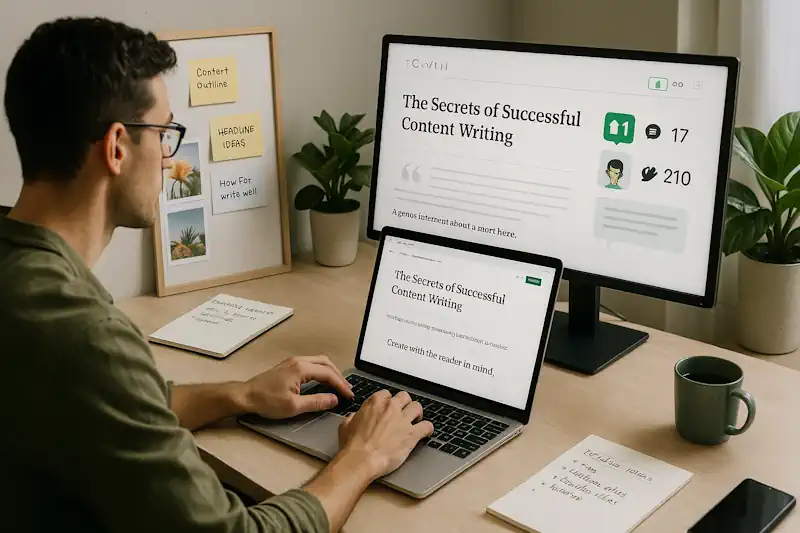
Medium is a platform built for readers who enjoy thinking, reflecting, and learning through words, not skimming. The audience here is more patient than what you’ll find on fast-paced apps.
But that doesn’t mean your content can be slow, sloppy, or unclear. Readers will give you their attention, but only if you earn it. The content that resonates most on Medium hits a balance between personal voice and practical value.
You don’t have to be an expert, but you do need to know how to hold someone’s interest and give them something worth their time. Engagement isn’t just about views. It’s about how long someone stays with your article, how far they scroll, whether they finish, and if they interact by clapping, commenting, or sharing.
Story Formats That Consistently Perform
Stories that resonate tend to fall into one of three categories: insightful breakdowns, personal experiences with universal lessons, or step-by-step guides. For example, an article titled “How I Landed My First 10 Freelance Clients Without a Website” works better than “Getting Freelance Clients.”
The former promises a specific experience with real takeaways. That kind of headline draws curiosity and sets expectations. Readers want to know the story and walk away with something useful they can try themselves.
Another strong type of content is what you might call the “silent struggle” format—writing about things people go through but rarely talk about, like burnout, creative insecurity, or losing motivation.
These pieces often go viral because they make people feel seen. As long as they’re grounded in a helpful or hopeful angle, they work well.
Crafting Magnetic Headlines and Subtitles
The title of your article is the gateway. On Medium, titles don’t need to be clickbait, but they do need to create tension, intrigue, or value. Good titles are specific. They often answer a “why” or a “how.” Think “Why My $500 Course Flopped (And What I Did Next)” or “How I Doubled My Email List by Ditching Lead Magnets.”
Subtitles add a second hook and let you clarify what the article delivers. They show up on article previews and are often the deciding factor when a reader is hovering over whether to click.
The Architecture of Readable Content
Structuring your content is critical. Long blocks of text will make even the most loyal reader bounce. Use short paragraphs—two to four lines max. Break up ideas with subheadings that guide the reader through your points.
Add lists only when they make the content easier to understand, not just to pad out the post. Readers like to skim at first before committing to a full read, so your formatting should support that. Use bold text sparingly to highlight important thoughts, but don’t rely on it to carry the message.
Strategic Use of Images and Media
Images and media can enhance a story, but only when they’re used with purpose. A high-quality header image helps set the mood. Within the article, screenshots, charts, or infographics can clarify complex ideas.
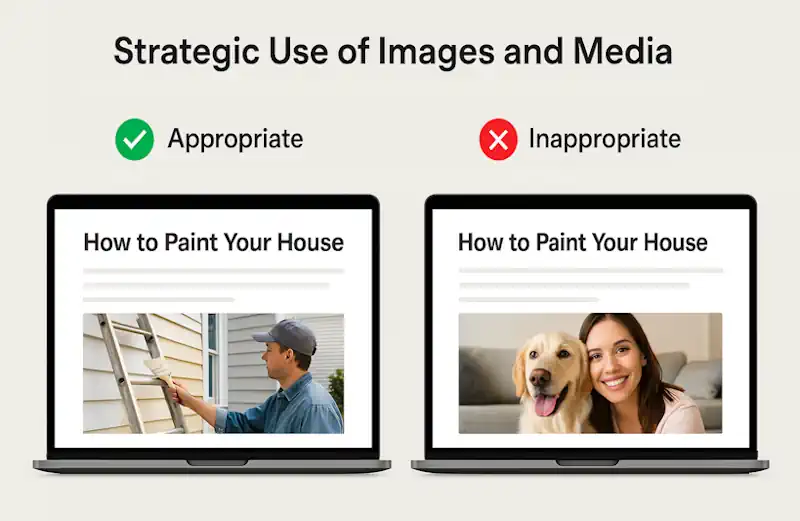
For instance, if you’re explaining how to set up an automation tool, showing the actual steps visually makes the article more practical. On the other hand, if you’re writing a narrative or an opinion piece, images can be distracting unless they add emotional weight or context. Keep the media lightweight. Too many visuals can slow loading and pull attention away from your core message.
Mastering Medium’s Editor for Professional Results
Medium’s editing tools are simple by design, but knowing how to use them well makes a difference. Use H1 for the main title, H2 for section headers, and H3 for subpoints. Insert dividers to visually break up transitions.
Use pull quotes when you want to highlight a key insight or provoke reflection. Just double-tap enter to add space between ideas. Embed links naturally—don’t just slap a bunch of URLs at the end. Medium articles look clean because they’re built to read like stories, not sales pages or technical documents. Keep your formatting aligned with that expectation.
Publication Strategy: Self-Publishing vs. Publications
When it’s time to publish, you have two options: submit your piece to a publication or publish it directly from your profile. Self-publishing gives you full control and speed. Your article appears on your profile immediately and can be indexed by Medium’s algorithm.
However, if you want built-in readership, submitting to a publication is often the better choice. Publications are curated collections of stories under a specific theme. Many have thousands of followers, and getting accepted means your work shows up in their feed, not just your own.
To find a publication, search for ones that regularly feature stories in your niche. For example, if you write about online business or freelancing, check out Better Marketing, Start It Up, or The Startup.
Read their submission guidelines carefully. Some want drafts sent through email, others ask you to request to be added as a writer. Be prepared for rejection or silence. It’s normal. Once accepted, though, your articles can benefit from the publication’s audience, reputation, and editorial standards.
Consistency: The Underrated Engagement Driver
Regardless of where you publish, consistency matters more than perfection. One great article won’t build your reputation. A consistent stream of good articles will. Try to publish once a week, or at the very least, every other week.
When people land on your profile, they’re more likely to follow you if they see you’re active. Medium also favors writers who show up regularly. Their algorithm takes frequency into account when deciding whose content to surface. Don’t write filler just to hit a deadline, but don’t disappear for weeks, either.
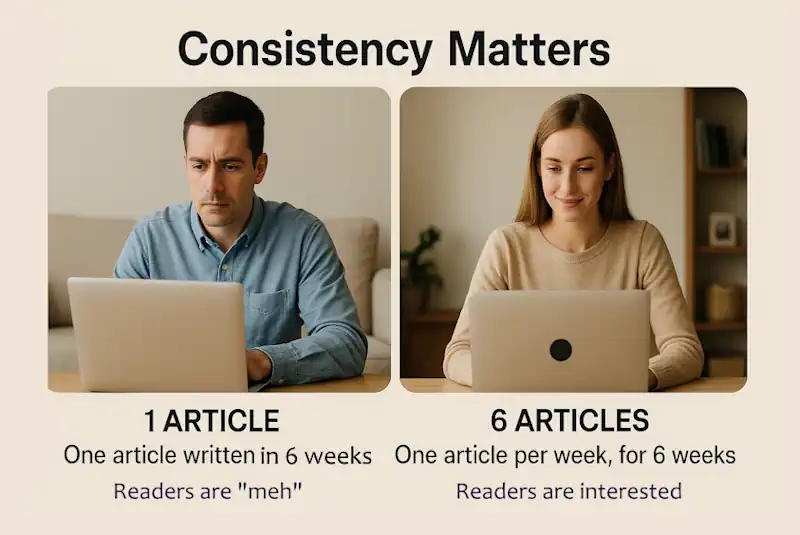
The Content Republishing Strategy
Republishing existing blog content is one of the smartest ways to grow your Medium presence quickly. If you’ve already written articles for your personal site, don’t let them gather dust.
Medium lets you repost them without hurting your original SEO rankings, as long as you use the canonical link feature. When you import a story using Medium’s built-in tool, it automatically tags the original post as the canonical source. This tells search engines that your blog is the original source and prevents duplicate content issues.
This republishing strategy is perfect for entrepreneurs who already have a content library. Instead of starting from scratch, you can adapt what’s working elsewhere and give it a second life on Medium.
For example, if you wrote a post on your site about five common email marketing mistakes, you can tweak the intro and republish it with a Medium-optimized title. If your site is monetized through products or affiliate links, this becomes a content funnel. You’re not just creating content for Medium—you’re using Medium to distribute content that already earns.
Testing and Optimizing Content Performance
Republishing also helps you test content performance. You might find that a post that flopped on your blog gets thousands of reads on Medium. Or that something which quietly earned traffic on Medium ends up being a strong addition to your site’s lead funnel.
The crossover benefits stack quickly. And because Medium surfaces older posts that still get attention, republished content continues to work for you over time.
Crafting Powerful Introductions
Your first paragraph determines whether readers stay or bounce. Unlike SEO-driven content, Medium introductions should be crisp, intriguing, and emotionally resonant. Avoid starting with definitions or obvious statements that readers already know.
Instead, try these proven introduction techniques:
- The unexpected truth: Start with a counterintuitive statement that challenges conventional wisdom
- The personal story hook: Begin with a relevant, compelling moment from your experience
- The direct problem address: Name the specific pain point your reader is experiencing
- The curiosity gap: Hint at valuable information that will be revealed throughout the article
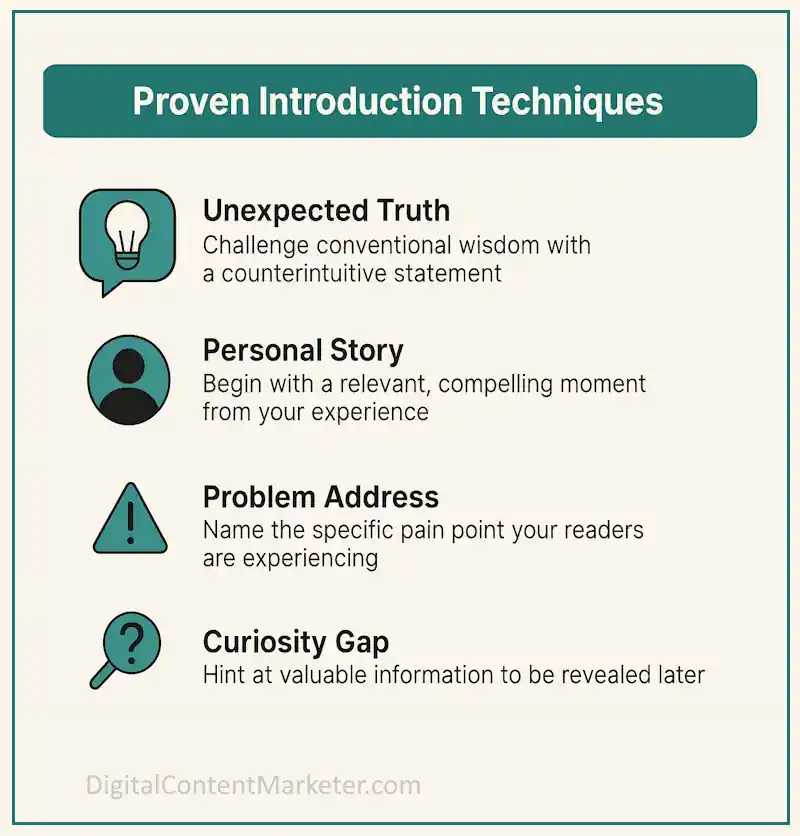
Here are four different introduction examples for a Medium article about productivity, each using a different proven introduction technique:
1. The Unexpected Truth
“Productivity apps are making you less productive. Every new organization tool, time-tracking system, and efficiency hack you download creates another system to maintain, another notification to manage, and another distraction disguised as a solution. The most productive people I know have deleted more apps than they’ve installed this year.”
2. The Personal Story Hook
“Last Tuesday, I stared at my color-coded productivity system, 17 unchecked to-do items glaring back at me, and closed my laptop. I walked to the park without my phone and sat for an hour doing absolutely nothing. When I returned, I completed more work in three hours than I had in the previous three days. That’s when I realized everything I thought I knew about productivity was wrong.”
3. The Direct Problem Address
“You’ve tried everything to get more done. The Pomodoro technique. Time-blocking. Morning routines. Productivity apps. Yet you still end each day feeling like you’re falling behind, with your most important work untouched and your stress levels rising. What if the entire approach you’ve been taught about productivity is fundamentally flawed?”
4. The Curiosity Gap
“There’s a productivity method that the world’s top performers use that you won’t find in bestselling books or trendy YouTube videos. It contradicts almost everything taught by today’s productivity gurus, yet it’s responsible for some of history’s most important creative and business breakthroughs. By the end of this article, you’ll understand why conventional productivity advice is failing you—and what to do instead.”
Each of these introductions sets up the same article about productivity but uses a different hook to capture the reader’s attention. All are concise, avoid starting with definitions or obvious statements, and aim to make the reader want to continue reading.
Whatever approach you choose, make your first paragraph short, punchy, and impossible to ignore.
The Art of the Medium Call-to-Action
Medium readers are sensitive to overly promotional content, but they still want to connect with writers they enjoy. Your call-to-action (CTA) strategy should reflect this balance:
- Primary CTA: Place your most important action request at the end of your article (following your email list, downloading a resource, etc)
- Contextual CTAs: Weave softer prompts naturally into your content where relevant
- Profile CTA: Optimize your bio with a standing offer for all visitors
- First-paragraph CTA: For returning readers who already trust you, an early mention of your latest offer can work well
The best CTAs offer clear value rather than asking for something. “Grab my free template that implements everything in this article” works better than “Sign up for my email list.”
Storytelling Frameworks for Maximum Engagement
Stories are engagement magnets on Medium. To structure your stories effectively, consider these proven frameworks:
- The Hero’s Journey: The Reader faces a challenge, encounters obstacles, finds a solution, and transforms
- Before-After-Bridge: Describe the problem situation, paint the picture of the solution, then explain how to get there
- Problem-Agitation-Solution: Identify the problem, emphasize why it hurts, then provide relief
- The 5 Ws Method: Structure your content around Who, What, When, Where, and Why
These frameworks give your content natural momentum that keeps readers scrolling to the conclusion.

Data-Driven Writing: What Medium Analytics Tell You
Medium provides valuable data about your content performance. Pay attention to these key metrics:
- Read ratio: The percentage of viewers who read your entire article
- Average read time: How long people spend with your content
- Internal vs. external views: Whether traffic comes from within Medium or outside sources
- Follower conversion: How many readers become followers after reading
Use these insights to refine your approach, doubling down on what works and adjusting what doesn’t.
The key to getting the most out of Medium is to treat it like a strategic outlet, not a dumping ground. Plan your content with the reader in mind. Write as if someone is paying you directly for your insight and your clarity. Format your posts to make them feel approachable, even if the content is dense.
Use tools like headlines, visuals, and structure to carry your message, not distract from it. Publish on a schedule, and don’t let content sit on your blog when it could be getting views, shares, and claps on Medium.
Medium rewards engagement, but that engagement starts with how you write. Compelling content doesn’t shout—it connects. It respects the reader’s time, gives them something useful, and keeps them reading until the end.
When you build that kind of reputation, the platform itself starts to work in your favor. Your articles get recommended, your profile grows, and your writing starts to generate more than traffic. It generates trust, and trust is where conversions begin.
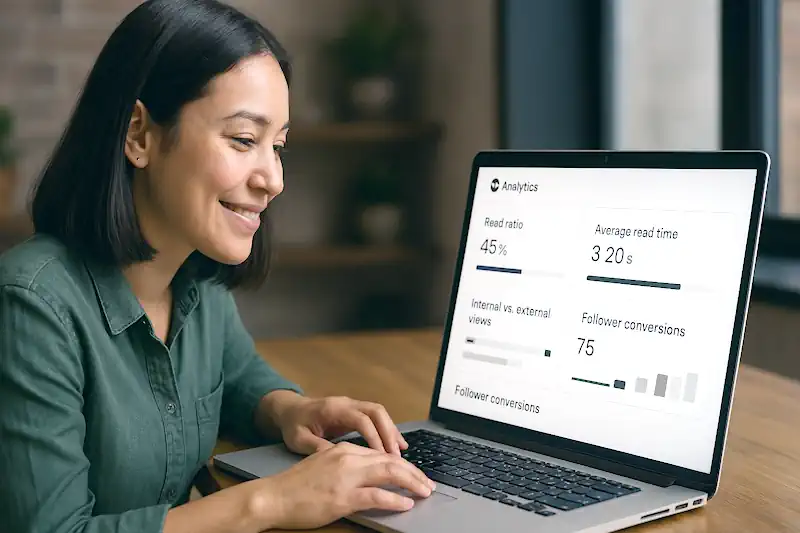
This was part 6 in our 11-part Medium marketing series. Next in our series: Active Audience Building: Medium Engagement Tactics That Convert – Learn how to build and nurture relationships with your Medium readers. Or return to the intro, where you’ll find the full series’ Table of Contents.

